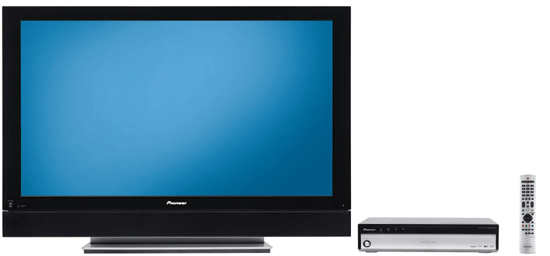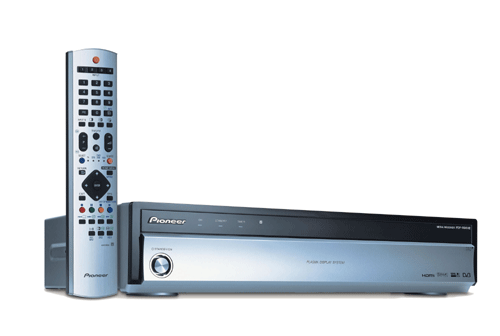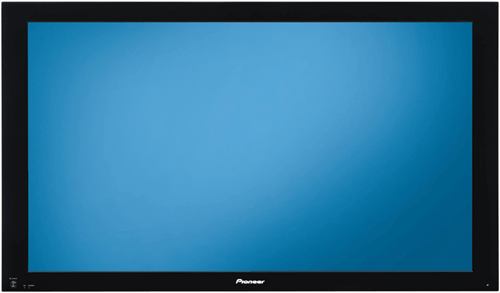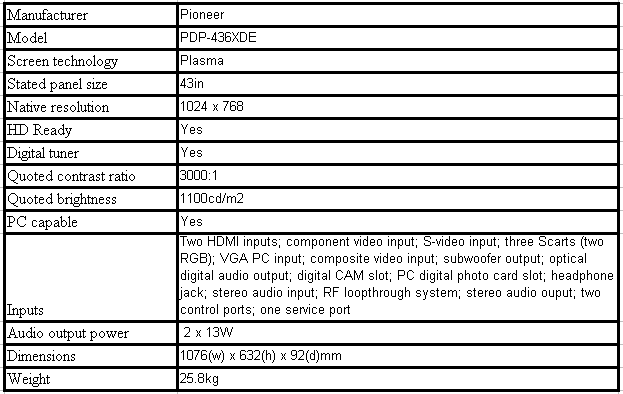Pioneer PDP-436XDE Review
Pioneer PDP-436XDE
If you thought that plasma was dead, think again. This could be the best HD TV out there!

Verdict
Key Specifications
- Review Price: £2800.00
Once the shining light of TV technology, plasma’s aura is starting to wane so far as an increasingly LCD-obsessed public is concerned. Clever spin-doctoring, savage price cutting and ever-bigger screen sizes from LCD makers have started to push plasma so far into the background that we’re starting to think it needs to sign up Max Clifford if it’s going to survive. Either that or the latest screens to carry the plasma flag, like Pioneer’s PDP-436XDE, need to be so darned good that they win punters over with their sheer quality.
The 436XDE makes a solid start on this daunting mission by looking quite stunning. The high-gloss finish on the jet-black screen frame creates an impression of both opulence and robust build quality. And the thinness of the frame ensures that the 43in screen doesn’t occupy any more of your living room space than necessary. You should note, though, that the screen as described does not include built-in speakers. The speakers provided are in fact detachable, giving you the flexibility of either fastening them to the TV or mounting elsewhere. Or, of course, you may just leave them in the box and use your own home cinema speakers instead.

The speakers aren’t the only thing not built into the 436XDE. Its TV tuner and connections are also sited externally, inside a separate AV multimedia receiver/switching box. Few manufacturers use such external receivers these days, though there can be advantages; not least the fact that if you’re thinking of wall-hanging your TV, it’s much easier to live with/hide a single cable connecting the screen to the receiver than the usual cable spaghetti caused by directly connecting all your AV gear.
Sockets on the external receiver are prodigious. Particularly eye catching is the future proofing offered by two HDMI sockets – double what most TVs currently carry. But also gratifying to find are three SCARTs, component video jacks, a D-SUB PC input, a multi-format card slot for direct viewing of digital photos, a subwoofer line output, an optical digital audio output, and a slot for adding subscription services like Top Up TV to a built in digital tuner.
Did we say digital tuner? Sure did. What’s more, this tuner is backed up by full support for the 7-day electronic programme guide offered by the Freeview terrestrial digital service.
The digital tuner is actually just the tip of a monster feature iceberg, too. The innovations start down at core manufacturing level, with Pioneer introducing two key new features for its sixth generation of plasma screens. First, the plasma cells are built using a new ‘deep waffle rib’ design that apparently reduces light and colour leakage between separate cells. Second, a new Crystal Emissive Layer applied to each plasma chamber boosts the stability of the gas plasma light discharge, resulting, it’s claimed, in better brightness and contrast, as well as greater energy efficiency.
The 436XDE’s picture processing, meanwhile, comes courtesy of the latest generation of Pioneer’s PureDrive II engine. This comprises all manner of image trickery, including MPEG noise reduction (for cleaning up the blockiness seen on weaker digital TV broadcasts), multiple contrast boosting measures, and a ‘3D Y/C’ filter aimed at improving clarity and sharpness.

There’s a new ‘I-Clear Drive’ technology, too, which Pioneer has developed to make colour gradations more subtle and, as a result, pictures look more layered and three-dimensional.
We could go on for hours about everything else the 436XDE has to offer, but for the sake of your sanity and our servers, we’ll restrict ourselves to just a couple more points. One is that the set has the facility to have its picture settings configured according to Image Science Foundation picture calibration guidelines (provided you can be bothered to find someone qualified to do the job).
Also, the set is extremely rare in today’s TV market in that it’s compatible with the up and coming 1080p high definition picture format. In case you’re not familiar with it, 1080p goes a step further than the AV world’s high-def ‘standards’ of 720p and 1080i. And it has become a hot potato since Sony announced 1080p output for both its Playstation 3 games console and Blu-ray high definition DVD players.

With so many features to cover, the 436XDE hasn’t left us with much room to discuss its performance. But actually we could make do with just two words: simply breathtaking…
Starting with its colours, we found outrageously rich, vibrant saturations, endlessly subtle blends, and tones that remain completely natural – even with people’s skin colouring – at all times.
Also impressive is the 436XDE’s rendition of black, helping give TV shows and especially films a striking sense of depth. In this regard the plasma 436XDE embarrasses many of the current LCD fraternity, which tend to suffer with dark areas that are obscured by a sort of flattening grey mist.
Next, the Pioneer’s picture manages to combine unusual sharpness and clarity with an almost complete absence of video noise of any type. This is particularly true with immaculate high definition sources like Elder Scrolls: Oblivion on an Xbox 360, but actually standard definition pictures like those from the digital tuner also look cleaner than we’re used to seeing them on a screen of this size.
Usually even the best flat panel TV has some picture flaw among all the good stuff, but in this Pioneer’s case its pictures really do get frighteningly close to perfection. In fact, our only concerns are more ‘housekeeping’ than actual performance woes.

First, we feel that the TV seems rather more susceptible to screen burn than most current plasma TVs and all LCD TVs. Screen burn occurs in plasma technology when you leave a particularly bright part of a picture, like a channel logo, on screen for too long. The bright image portion ‘tires’ the phosphors in that part of the screen so that under extreme circumstances you can be left with a permanent shadow of the bright item ‘burned’ into your picture. So our advice with the Pioneer is that you take special care not to leave the same channel logo on screen for too long at a time, especially within the first 100 hours of the TV’s working life.
Our second concern is that you need to be careful with the TV’s processing options or else motion starts to look a bit jerky. But provided you follow these fairly simple rules, it’s all (spectacularly) good.
The sonics from the 436XDE’s detachable speakers do the superlative pictures proud, combining almost ‘hi-fi’ levels of detailing and subtlety with bags of distortion-free power, and adding plenty of vocal clarity and bass depth into the bargain.
”’Verdict”’
As you may have guessed, we rather like the 436XDE. In fact, we love it. Its pictures are the best we’ve seen on a 42in-plus TV to date, and as such they suggest that while it might not be the fashionable flat TV option right now, plasma still has the potential to be the best.

How we test televisions
We test every TV we review thoroughly over an extended period of time. We use industry standard tests to compare features properly. We’ll always tell you what we find. We never, ever, accept money to review a product.
Trusted Score
Score in detail
-
Value 9
-
Image Quality 10

